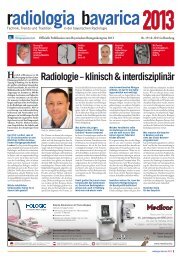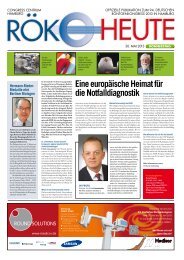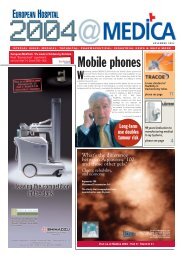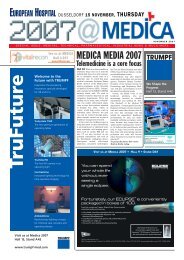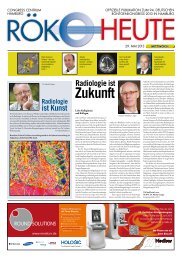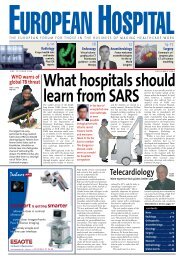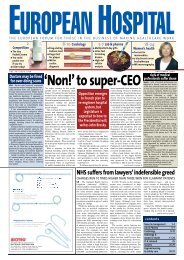PET scanning the heart cuts costs - European-Hospital
PET scanning the heart cuts costs - European-Hospital
PET scanning the heart cuts costs - European-Hospital
Create successful ePaper yourself
Turn your PDF publications into a flip-book with our unique Google optimized e-Paper software.
<strong>the</strong> never ending story<br />
Helga Fischer (right), radiographer at <strong>the</strong><br />
University <strong>Hospital</strong> for Radiodiagnostics at<br />
<strong>the</strong> Allgemeine Krankenhaus, Vienna, and<br />
former Vice-President of Austria’s RTA<br />
Association, which focuses on MR, lectures<br />
and workshops for imaging processes,<br />
describes experiences, covering a year and<br />
a half, with a PACS system, and suggests ways forward<br />
(resolution between 1 and 3 mega<br />
pixel) are also installed in <strong>the</strong> hospitals.<br />
The layout of <strong>the</strong> PACS is designed<br />
and dimensioned to include:<br />
● Images saved in <strong>the</strong> short as well<br />
as long-term archive after acceptance<br />
by <strong>the</strong> server.<br />
● The short-term archive allows<br />
relatively fast loading of archived<br />
images.<br />
● The long-term archive is<br />
designed for 10-year storage. Data<br />
are only rarely retrieved.<br />
● Pre-fetching should mainly take<br />
place from <strong>the</strong> short-term archive.<br />
● For security reasons, data must be<br />
present at least twice, whereby one<br />
copy should be stored ‘remotely’.<br />
Present workflow - This practically<br />
depends on people and <strong>the</strong> ‘green<br />
folder’, a collective folder used to<br />
transport all findings, images, language<br />
cassettes and task lists for<br />
<strong>the</strong> examinations. The RIS and<br />
PACS are presently used as passive<br />
systems.<br />
Even though workflow is<br />
presently very smooth, <strong>the</strong>re are<br />
three sources for errors and timeconsuming<br />
complications:<br />
Time pressure at central planning -<br />
Because processes at central planning<br />
are so fast but <strong>the</strong> IT input<br />
does not happen synchronously<br />
(capture KIS - RIS), <strong>the</strong> patient<br />
index numbers are written manually.<br />
Transfer of <strong>the</strong> worklist to modalities<br />
- There is no consistent transfer<br />
of <strong>the</strong> electronic work list from RIS<br />
to <strong>the</strong> modalities (<strong>the</strong>y are older<br />
models). All relevant data must be<br />
entered manually particularly for<br />
<strong>the</strong> older modalities, which is a<br />
potential source for errors.<br />
Diagnostic findings - The diagnostic<br />
process (dictation, writing,<br />
proof-reading, corrections and<br />
revision) and particularly <strong>the</strong> interaction<br />
between doctors and <strong>the</strong><br />
typing-pool, is clearly a source for<br />
errors and <strong>the</strong>re’s a potential for<br />
time optimisation.<br />
Since PACS arrived, what are <strong>the</strong><br />
most important disadvantages and<br />
advantages?<br />
Disadvantages<br />
● MTRA was not integrated into<br />
selection and purchasing process<br />
● Selection, purchasing and implementation<br />
took too long, so when<br />
<strong>the</strong> system effectively went into<br />
operation, it was already too small<br />
● When pictures are printed from<br />
PACS (e.g. CT) and <strong>the</strong> person<br />
involved does not ensure <strong>the</strong> printer<br />
is at <strong>the</strong> right level, all pictures<br />
may be printed twice (expensive)<br />
● When <strong>the</strong>re is a problem within<br />
<strong>the</strong> IT system, <strong>the</strong> complete PACS<br />
system goes down<br />
● Under certain circumstances,<br />
images that are sent to <strong>the</strong> PACS<br />
are not saved in <strong>the</strong> right place; in<br />
which case <strong>the</strong> IT specialist must<br />
reprocess<br />
seca gmbh & co. kg. . Hammer Steindamm 9-25 . 22089 Hamburg, Germany<br />
Phone +49 40 20 00 00 0 . Fax 040 20 00 00 50 . www.seca.com<br />
RADIOLOGY<br />
Are you as well prepared as she is?<br />
seca 376 /seca 375 – digital baby scale with<br />
extra large weighing tray<br />
seca 835/seca 834 – digital baby scale also usable<br />
as fl oor scale for children<br />
● Retrieval of master images from<br />
<strong>the</strong> main storage can take up to<br />
hours; <strong>the</strong> IT specialist must be contacted<br />
● Data must be entered absolutely<br />
correctly when an examination<br />
takes place in rooms where a<br />
patient’s data cannot be transferred<br />
into <strong>the</strong> examination computer, o<strong>the</strong>rwise<br />
<strong>the</strong> images cannot be found<br />
in <strong>the</strong> PACS; <strong>the</strong> technician must<br />
reprocess in <strong>the</strong>se cases<br />
● High service and maintenance<br />
<strong>costs</strong><br />
● Display is monitor-dependent<br />
Advantages<br />
● Waiting times for <strong>the</strong> patients<br />
have reduced significantly<br />
● Examinations can start more<br />
promptly<br />
● Increased patient frequency is<br />
possible<br />
● There is reduced film development<br />
and thus fewer toxic developing<br />
substances<br />
● Lower film <strong>costs</strong><br />
● Better quality, as images can be<br />
saved digitally without losing data<br />
● Better availability for diagnostic<br />
findings, visits or interdisciplinary<br />
She’s ready for all eventualities. And like her, you want to be prepared as best as<br />
possible. There’s nothing better than <strong>the</strong> latest additions to seca’s pediatric range.<br />
Three electronic baby scales and an infantometer featuring state-of-<strong>the</strong>-art technology<br />
and innovative features – just what your patients are calling for. The seca 376/375<br />
scale has a shell-shaped weighing tray for extra safety. The seca 835 and seca 834<br />
scales offer great value for money. And <strong>the</strong> seca 416 infantometer is quite simply <strong>the</strong><br />
state-of-<strong>the</strong>-art in form and function. Get yourself prepared for all eventualities – with<br />
pediatric products from seca.<br />
seca 416 – mobile infantometer for measuring babies<br />
and infants<br />
consultations.<br />
Overview - At present <strong>the</strong> PACS<br />
has stored about 8,897,000<br />
images (files) with some 5,308<br />
GB (raw) total data volume.<br />
Computed tomography<br />
● 25,450 CT exams<br />
● average 238 images per picture<br />
● approx. 6 million data files<br />
Magnetic resonance<br />
● 10,494 MR exams annually<br />
● average 247 images per picture<br />
● approx. 2.5 million data files<br />
Additional modalities<br />
● 248,400 data files from gastro,<br />
bones, etc.<br />
continued on page 18<br />
29_03_142AZ_europ_hosp_A4_RZ.indd 1 21.04.2005 16:18:33 Uhr<br />
EUROPEAN HOSPITAL Vol 14 Issue 2/05 17



